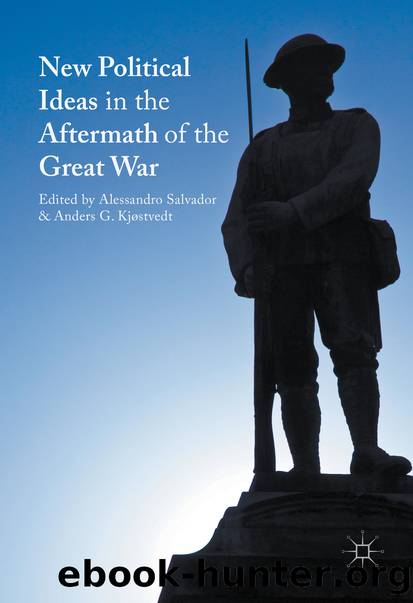New Political Ideas in the Aftermath of the Great War by Alessandro Salvador & Anders G. Kjøstvedt

Author:Alessandro Salvador & Anders G. Kjøstvedt
Language: eng
Format: epub
Publisher: Springer International Publishing, Cham
Organizing the Workers: The Stahlhelm Selbsthilfe
The Stahlhelm sections in central Germany had the highest number of members belonging to the working class. Therefore, it was in this area that interest in labour issues developed into a concrete organizational form. The veteransâ association was largely accused of anti-union behaviour because of their opposition towards the class struggle and the strikes. However, the local leaders pointed out that they did not serve the interests of the employers. On the contrary, they aimed at a new way of arranging the labour conflicts by suggesting cooperation between employers and employees. This way of thinking emerged from their view of society as an organic body in which all parts should cooperate for a common aim, as soldiers and officials did at the front. 20
In the first months of 1928, the Stahlhelm in central Germany launched a new initiative to gather and organize the workers, the Stahlhelm Selbsthilfe (Stas). The idea originated from Bernhard Rausch, the leader responsible for the local group in Halle, and quickly met the consent of Theodor Duesterberg. The Stas became a sub-structure that took responsibility for all previous social activities of the Stahlhelm in the area of central Germany: food and clothes collection, job-placement, housing and workersâ kitchens. However, it also became a radiating point for more ideological goals, like defending workersâ rights, organizing private social and unemployment insurances and, in some cases, fighting against socialist workers on strike. 21
The organization of the Stas in central Germany started with the creation of workersâ cells in the factories, the Stas Betriebsgruppen. The cells worked in coordination with social referents and groups within the local sections of the Stahlhelm, the Stas Gruppen. The aim of these groups was to spread the idea that employers and employees shared the common goal of economic prosperity and therefore should work in mutual interest. Furthermore, the Stas promoted the idea of individual negotiation between workers and employers, creation of a social saving system and of salaries based on individual performance. 22
Rausch was very active in prompting the promotion of his organization as federal structure within the Stahlhelm. During 1929 he was allowed by the national direction to conduct research aimed at discovering how many workers belonged to the Stahlhelm, how many of them had already joined workersâ organizations and how many of the independent would have joined a Stahlhelmâs workers association. The results of questionnaires distributed to all local sections encouraged the national direction to declare the Stas as an official federal organization of the Stahlhelm in April 1929. 23
The main aims of the Stas were to provide an organized system of social self-help and assistance to workers belonging to the Stahlhelm. In a short time, the organization integrated all the social activities of the veteransâ association and provided a national and coordinated tool to improve efficiency in the field of economic assistance as well as labour issues. It also provided a system of social saving, by collecting quotes from all participants to create a fund for health and unemployment insurances and to finance the charity for Stahlhelm members in need.
Download
This site does not store any files on its server. We only index and link to content provided by other sites. Please contact the content providers to delete copyright contents if any and email us, we'll remove relevant links or contents immediately.
| Elections & Political Process | Ideologies & Doctrines |
| International & World Politics | Political Science |
| Public Affairs & Policy | Specific Topics |
| United States |
The Secret History by Donna Tartt(16606)
The Social Justice Warrior Handbook by Lisa De Pasquale(11485)
Thirteen Reasons Why by Jay Asher(7780)
This Is How You Lose Her by Junot Diaz(5753)
Weapons of Math Destruction by Cathy O'Neil(5029)
Zero to One by Peter Thiel(4816)
The Myth of the Strong Leader by Archie Brown(4785)
Promise Me, Dad by Joe Biden(4440)
Stone's Rules by Roger Stone(4412)
Beartown by Fredrik Backman(4403)
How Democracies Die by Steven Levitsky & Daniel Ziblatt(4392)
The Fire Next Time by James Baldwin(4336)
100 Deadly Skills by Clint Emerson(4070)
A Higher Loyalty: Truth, Lies, and Leadership by James Comey(4024)
Rise and Kill First by Ronen Bergman(4008)
The David Icke Guide to the Global Conspiracy (and how to end it) by David Icke(3875)
The Farm by Tom Rob Smith(3869)
Secrecy World by Jake Bernstein(3773)
The Doomsday Machine by Daniel Ellsberg(3725)
